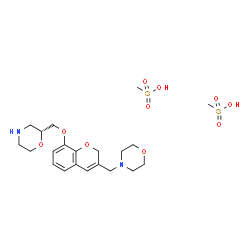1217474-40-2
| Name | NAS-181 |
|---|---|
| Synonyms |
Morpholine, 2-[[[3-(4-morpholinylmethyl)-2H-1-benzopyran-8-yl]oxy]methyl]-, (2R)-, methanesulfonate (1:2)
MFCD06798366 (2R)-2-({[3-(4-Morpholinylmethyl)-2H-chromen-8-yl]oxy}methyl)morpholine methanesulfonate (1:2) |
| Description | NAS181 is a potent and selective antagonist of rat 5-HT1B receptor, with a Ki of 47 nM. NAS181 shows 13-fold selectivity for r5-HT1B over bovine 5-HT1B receptor (Ki=630 nM). NAS181 increases the 5-HT turnover and the synaptic concentration of 5-HT by inhibiting terminal r5-HT1B autoreceptors[1][2]. |
|---|---|
| Related Catalog | |
| Target |
Rat 5-HT1B Receptor:47 nM (IC50) |
| In Vitro | NAS181 has very low affinities (Ki>3000 nM) for all other receptors examined, including 5-HT2A, 5-HT2C, 5-HT6, and 5-HT7, α1-, α2-, and β-adrenoceptors, and dopamine D1 and D2[1]. NAS181 (10-1000 nM) dose-dependently potentiates the K+-stimulated [3H]-5-HT release in preloaded rat occipital cortical slices[1]. |
| In Vivo | NAS181 (1-10 mg/kg; s.c.) dose-dependently increases acetylcholine (ACh) release in the frontal, ventral hippocampus cortex and VHipp[1]. NAS181 (20 mg/kg; s.c.) enhances the 5-HT turnover in four rat brain regions (hypothalamus, hippocampus, striatum, and frontal cortex) with about 40%[1]. NAS181 (3 mg/kg; s.c.) produces a significant increase in the number of wet dog shakes in rats[1]. Animal Model: Adult male Sprague-Dawley rats (250-300 g) Dosage: 1, 5, 10 mg/kg Administration: S.c. in the scruff of the neck Result: Increased the ACh release in the frontal cortex, reaching the maximal value of 500% of the control group within 80 min after the injection of the highest dose. Increased the ACh releases in VHipp with a maximum of 230% of the control values at 80 min after the injection of the highest dose. |
| References |
| Molecular Formula | C21H34N2O10S2 |
|---|---|
| Molecular Weight | 538.632 |
| Exact Mass | 538.165466 |
